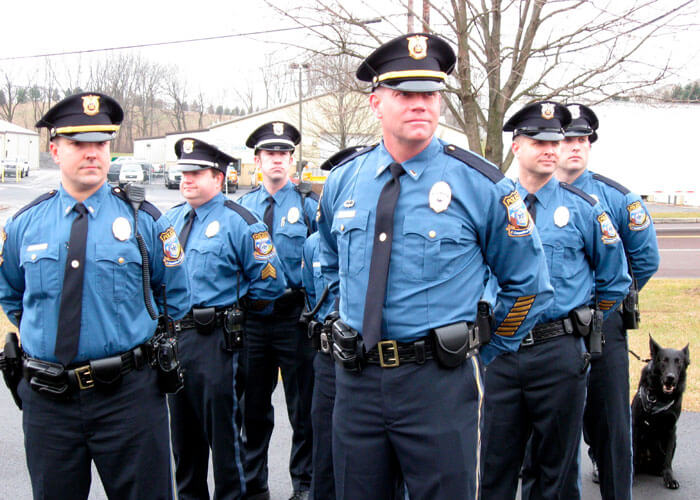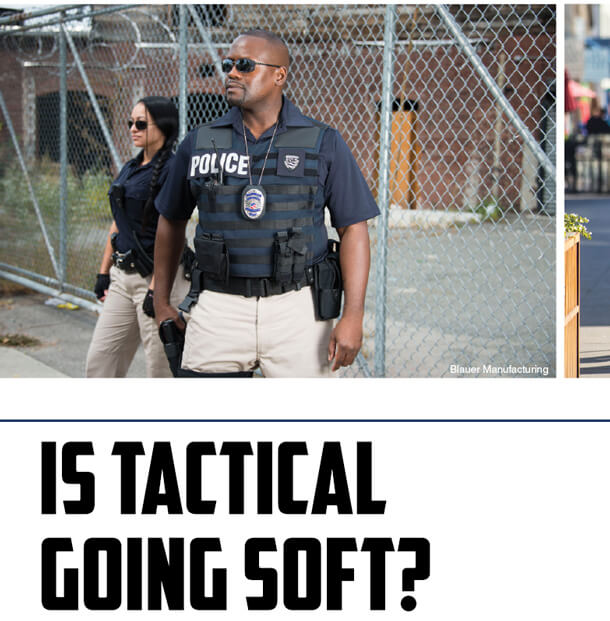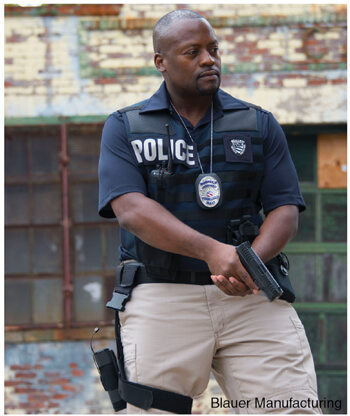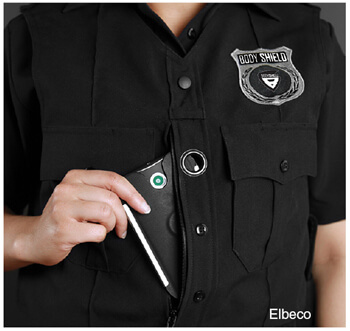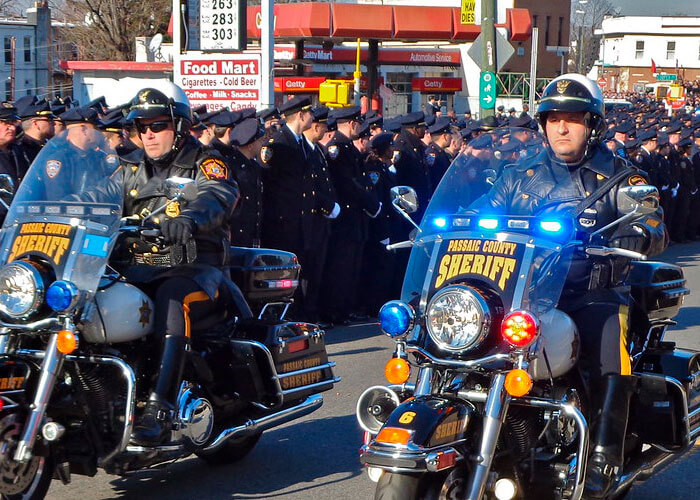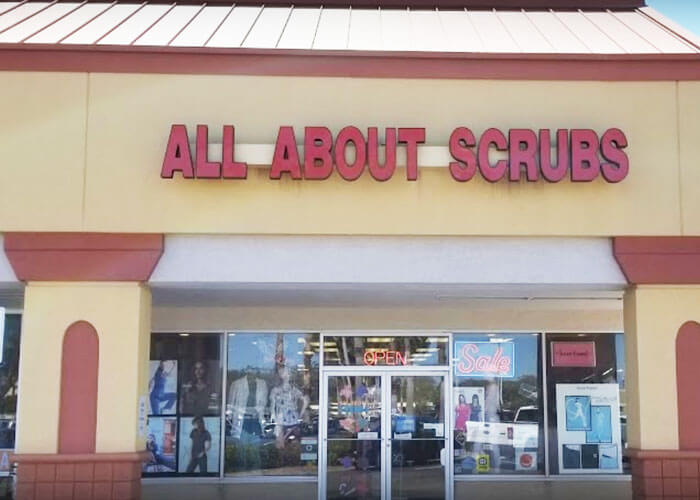A Presidential Taskforce and public outcry are fueling debate over appearance and a softer approach for police uniforms
By Jackie Rosselli
Police departments around the country are suffering from an image problem. Incidents in Ferguson, Baltimore, Chicago, New York and other cities have arguably called into question tactics used by law enforcement during times of crisis.
But it isn’t just the response that is raising eyebrows. It’s the uniform too. Dressed like the military in a war zone, some suggest that police look more like an occupying force rather than a trusted community protector. Even the President weighed in, convening a task force last year that called for, among other things, the wearing of “soft look” uniforms and the removal of riot gear “as soon as practical.”
The perception of a militarized police force for some has become a reality, resulting in a loss of respect and trust in those whose mission it is to serve.
Of course, it was the need to protect and serve that gave rise to the tactical look in the first place. In a post-Sept. 11, 2001, world, BDU-styled uniforms offered the functionality needed for 21st century policing and provided the comfort a new generation of officers was seeking. Generous federal appropriations equipped departments large and small, urban and rural, with high-powered weapons, gear and armored vehicles. The Class A look, the ultimate conveyor of command presence, became a quaint symbol of a bygone era. In the name of safety, comfort and practicality trumped appearance.

Now the pendulum has begun to swing in the other direction, with departments around the country trying to repair their images by revisiting their uniform and equipment needs. To be sure, no department is going back to clarino shoes, dress shirts and campaign hats while on patrol, nor are certain units – think Special Ops or SWAT – shedding their tactical wear any time soon.
But as concern over appearance grows, a new look is emerging – one that blends the style of a Class A with the sensibilities of a tactical outfit, a so-called “modified Class A.” Still, not everyone is jumping on the less-tactical bandwagon. Some departments are doubling down, going even more tactical, citing safety as reason to stay the course. And others wonder why a polo and a pair of cargo pants would create such a stir in the first place.
Are departments taking a less tactical approach to their uniform needs? The answer is a definite maybe. It seems to depend on the definition of tactical, on the location and on who’s doing the decision making. Read on to learn what customers are telling dealers and manufacturers.
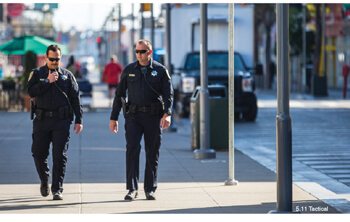 The Great Divide: Chiefs vs. Rank & File
The Great Divide: Chiefs vs. Rank & File
When it comes to uniforms and appearance, there’s always been a divide between command staff who want a neat, clean, professional look and those in the field who opt for garments that are durable, comfortable and functional. Age also plays a role. For older chiefs, it’s all about appearance; younger chiefs, fresh off the battlefields of Iraq or Afghanistan, are more apt to provide creature comforts for their staff.
Tactical uniforms may remain popular with the rank and file, but what they have come to represent is not.
“The look is not consumer friendly,” says Dan Balzofiore of Fechheimer. “You don’t want your police department standing in front of a school looking like they’re going out to warfare. You want them to look professional and authoritative, not threatening.”
The backlash has been growing over the past few years in some areas, creating a public relations nightmare for chiefs across the country.
“Chiefs are battling between public perception and officer safety,” adds Erie Skoczylas of Unitex Direct. “Older chiefs tend to look for a professional, softer look; younger chiefs want whatever will let their guys do the jobs better.”
Stephen Blauer of Blauer Manufacturing says, “We hear from chiefs all the time who don’t like the direction things are going in. They like the traditional look, like the idea of community policing, the idea that cops are there to help. But there’s increasing pressure to satisfy the younger police officer who is coming back from Afghanistan and is used to wearing a more military-type uniform that he feels is practical, cheaper and easier to clean and, in his opinion, more comfortable.”
For younger officers, tactical wear is less about looks and more about practicality. “The more tactical the product, the easier it is for an officer to store and rapidly deploy that gear,” continues Skoczylas.
Still, it can be difficult to tell the military from a police force in some areas. Take New York, a city with its own community policing problems. The NYPD is wear-testing new uniforms intended to bolster the department’s beleaguered image. “If you look like you’ve just stepped off a battlefield, you’re basically challenging your citizens, and you therefore won’t get the respect you deserve” says Rob Mustachi, whose company, Elbeco, is performing the wear test.
Others disagree. Frank Cappo, a 13-year veteran of the Overland Park PD and now a vice president at 5.11 Tactical, says the uniform has little to do with public perception. “The public doesn’t care if we wear pink shirts and green pants as long as our role is communicated in a professional way. If an officer does his job right, it doesn’t matter what he’s wearing. It’s the few who do it wrong that turns the spotlight on what they’re wearing.”
If departments are taking a less tactical approach to their uniform needs, Cappo says, 5.11 Tactical hasn’t seen it. The company’s in-demand product line includes traditional Class A looks and uniforms with cargo pockets on the legs. “Agencies are still looking for more function, whether through, fabric, fit or design regardless of the uniform,” he says.
Defining “Tactical”
For some, it comes down to how the word “tactical” is defined. The style often teeters between casual and aggressive, with various looks in between. “What’s tactical to one department is not to another,” says John Tragiai of Keeprs. “To one chief, tactical might be a six-pocket cargo pant. To another, tactical might be BDU pants with a molle vest. Opinions vary.”
“Personally, I think cargo pants can be paired with a nice polo shirt. You still have comfort and mobility, but it’s not a full-on tactical look,” adds Miranda Brock of Louisiana’s Caplan’s.
Often it is not even the uniform itself that is aggressive looking but the gear and accessories that accompany it, as Brock points out. “Everybody loves K-9 officers, and they are often wearing what most people consider tactical-style uniforms. The same officer might look completely different if you replace the dog with a ballistic helmet, shield and a baton, and if instead of a concealable vest underneath the shirt, he’s wearing an outer tactical vest.”
Cappo points out, “I haven’t heard from one police chief or newspaper reporter that thinks our product is too intimidating. It’s only a pair of cargo pants, after all.”
Tactical Still in High Demand
For rank and file staff, tactical uniforms are a necessity, even if they are controversial. “Our men and women out on the streets need to be more tactical,” notes Darrell Morrow of Vertx.
And most of the dealers interviewed were in agreement; if there’s a softening going on, they haven’t seen it. Appearance is important, they say, but for their customers, safety and functionality come first.
With locations in Minnesota and Georgia, Keeprs’ Tragiai says that, over the last five years, he’s seen departments go more tactical and for good reason. “Officers never know what they’re going to respond to,” he notes. “Whether it’s an incident like San Bernardino or an active shooter, having the most functional type of gear is critical today, and that includes the uniform, the type of pistol and the squad car they drive in.”
Skoczylas of Unitex Direct agrees. “Each time an officer is shot, you’ll hear them say over and over we need more tactical stuff,” he adds. “No department is changing to a softer look; if anything it’s the other way around. In fact the movement in Michigan has been to go more tactical; that is the change we’re seeing.”
The tactical look reigns even in the Northeast, where departments tend to embrace a more traditional appearance.
“Law enforcement is definitely more tactical-minded post-9/11,” says Joe Chiusolo of Turn Out Uniforms. “Years ago officers walked a beat in a neatly pressed uniform, but the world has changed. Just look at what happened in Paris and San Bernardino.”
Located in New Jersey, Turn Out services departments in that state as well as New York and Pennsylvania. “Have there been pockets of departments that evaluated tactical uniforms but have gone in another direction? Yes, but they’re not in droves,” he says.
Besides the safety factor, dealers said that tactical wear is just more practical. Officers are trained to do a variety of things and carry equipment to meet that training.
“It’s more of a matter of functionality,” Brock notes. “You wouldn’t necessarily want to be on the SWAT team and bust down a door wearing a four-pocket pant and a long-sleeve dress shirt. At the same time, it would be intimidating to be pulled over by a road patrol officer in full SWAT uniform and gear.”
Brock says that most of Caplan’s customers use a mix of tactical and traditional garments depending on the assignment. “We have a lot of departments who alternatively wear department-assigned or issued polo shirts aside from their usual dress or tactical uniforms. This seems to provide an overall softer, friendlier look for instance, if they are doing something in communications.”
That mix may be the solution as the tactical debate rages on. For those departments that are concerned with appearance, there are a number of products on the market right now that merge the traditional with the tactical, offering Class A materials with Class B features for a modified look.
Among the offerings in this new genre is Blauer Manufacturing’s ArmorSkin. Colorfast and available in several fabrications, ArmorSkin is designed to look like a uniform shirt when worn over an ArmorSkin Base Shirt, so it projects a more professional appearance than standard outer vests. “It’s very difficult to see whether they have it on or not, so they don’t lose their tactical advantage” says ArmorSkin creator Stephen Blauer. “If you’re wearing a full-scale tactical vest or a contrasting vest like they do in Chicago, it’s pretty obvious they have it on.”
Departments who have made the switch to ArmorSkin – LAPD, Boston PD, Florida Highway Patrol, Philadelphia PD and the Tennessee Highway Patrol to name a few – have done so primarily because of its clean, less-threatening look. But the product has also reduced one of the major complaints heard from officers these days: the pain from the weight of gear.
What’s carried on the duty belt of a beat cop has changed drastically over the last two decades. Today’s officer carries much more than a handgun, handcuffs and baton; the additional equipment adds weight that can cause injury to the hip and lower back. The added strain has forced some departments to move equipment off the belt and on to an external vest. While done for comfort, the resultant look is more tactical and aggressive.
Since ArmorSkin can be worn with suspenders, there’s no need to move equipment off the belt, although wearers can add a row or two of molle if desired. The suspenders move weight from the hips to the shoulders, improving posture and reducing the need for unconscious tweaking of the duty belt position throughout the day.
“When the army loads a soldier, they try to balance weight on front and back,” explains Blauer. “By putting suspenders under the ArmorSkin, you achieve that goal. And you allow the officer’s muscle memory to stay as is; he doesn’t have to change habit or relearn anything.”
ArmorSkin is patented and works right out of the package without the need for custom adjustments, reducing liability concerns. The ArmorSkin stays in the existing internal carrier, ensuring the ballistic protection designed by the manufacturer. It also can’t be pulled over an officer’s head; once it’s on, ArmorSkin can’t be pulled off. Blauer likens ArmorSkin to a phone case: the cover doesn’t affect the phone and how it works, but it protects it from damage.
Also striking a balance between professionalism and functionality is Elbeco’s BodyShield External Vest Carrier. Billed as the world’s first “smart uniform,” it’s the third generation in a line of carriers that includes the more tactical looking V-1 and V-2.
The BodyShield is designed to be worn outside the uniform for comfort while remaining virtually undetectable to the eye. The vest can also be taken off or opened on the side to cool down on a hot summer’s day.
The product addresses the ever-growing demand for on-body surveillance systems and can house any camera that’s on the market today, according to Elbeco’s Mustachi. “Whether it’s a clip-on carrier or an integrated system, it will accept any of the technology that’s out there.” And if the big zippered pouch isn’t being used for a camera, officers can store backup weapons in it instead.
As this issue goes to press, the BodyShield is being wear tested throughout the country. The product will hit the shelves in April 2016.
Elbeco has been moving to a softer approach for its tactical line over the last two years. The fit for some styles has been revamped for a more modern feel; gone are high-waist pants, and mesh vents on shirts are color matched for a clean, professional appearance. Pants made with rip-stop fabrics now feature hidden cargo pockets; the pocket bag is on the inside – only the small zipper opening is visible from the outside.
“You want the respect that a professional law enforcement uniform provides,” says Mustachi.
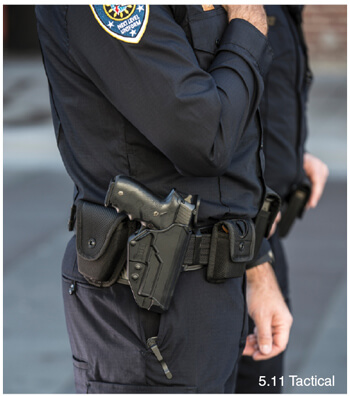 Tradition and Function, the 5.11 Way
Tradition and Function, the 5.11 Way
Yes, 5.11 Tactical is best known for its tactical wear, but its offerings also include a line of duty uniforms that combine the best of tradition with function.
Launched several years ago, 5:11’s PDU – Patrol Duty Uniform – is a 65/35 poly/cotton blend made in both twill and rip-stop fabric for a better fit and comfort. Colorfast and Teflon coated, the uniform is able to withstand the rigors of the job. As for the look, permanent creases and hidden closures ensure a crisp, sharp appearance. Keeping a clean appearance is easy because the uniform is wash and wear. “Officers spend a lot of time in the car; it’s their office and where they eat most of the time,” notes Cappo. The permanent creases ensure the sharp look regardless of how an officer completes his assignment.
Similar to the PDU Patrol Uniform is the Stryke PDU line of shirts and pants, available in both Class A and Class B styles. Stryke incorporates Flex-Tac mechanical stretch fabric for durability, performance and comfort in any environment. Permanent creasing keeps officers looking good at all times.
Keeping a Low Profile with Vertx
Marrying what chiefs want with what the field needs can be difficult, but Vertx has been doing exactly that from its inception. “Our original starting point was a low-profile pair of tactical pants,” says Morrow of Vertx. “It’s at the core of what we do.”
The Vertx brand offers an array of tactical products to departments looking for a low-profile design with superior fit and function. Take, for example, the company’s Phantom LT pants. Constructed of a 65/35 poly/cotton mini rip-stop fabric, the trousers contain multipurpose inset cargo pockets with bonus interior pockets that lessen the tactical appearance yet deliver maximum capacity. The pants are paired with the Phantom LT shirt, which is enhanced with Lycra knit side panels to provide cool stretchable comfort on hot days. Worn together, the look is neat, clean and utterly professional.
The drive toward a less aggressive-looking uniform has grown over the past several years, according to Morrow, leading several departments to make the switch to the Vertx brand. The look is also popular with what Morrow refers to as “the more progressive chiefs,” who choose the line for its everyday uniforms. “You don’t have to go to a BDU-looking uniform to achieve a tactical advantage,” notes Morrow.
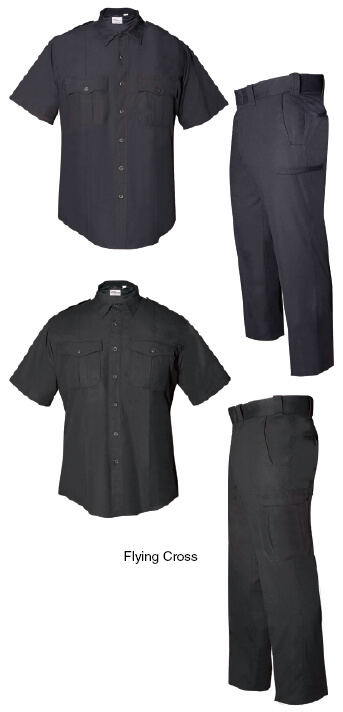 Flying Cross and the Functional Duty Uniform
Flying Cross and the Functional Duty Uniform
The Vertx brand, part of a family of products from Fechheimer, strikes a nice balance between looks and functionality. Departments seeking a more traditional appearance can also turn to another brand under the Fechheimer umbrella: Flying Cross.
Flying Cross is a classic brand, known for its exacting standards and impeccable style. Departments looking for a top-notch appearance often turn to Flying Cross for their uniform needs.
Combining the need for professional appearance with comfort and function, Cross FX is a functional duty uniform featuring comfort fabrics for all-day wear and design features that include articulation in the crotch, knees and arms, as well as functional features such as low-profile cargo pockets. The line is available in both Class A and Class B looks.
Available in a 65/35 poly/cotton blend, Class A features for the shirt include a no roll, Freedom collar design and a Supercrease military crease design in front and back.
A Freedom Flex waistband and gusseted crotch offers the comfort officers want, while the Supercrease system projects a sharp look to the public.
The Cross FX Class B uniform pairs day-to-day comfort with functionality without compromising appearance. The added features of an enhanced cargo pants pocket and MAP shirt pocket designs provide full functionality for all-day performance.
While the debate over tactical will undoubtedly continue, Tragiai and others agree: there’s a place for both looks. “Our job is to identify the needs of customers and provide solutions to their problems.”




